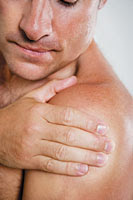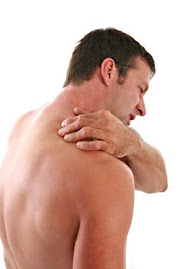The shoulder joint is one of the five major areas of the body involved in sports injuries. Sportsmen who over use the shoulder in throwing or overhead activities as in cricket bowlers, volleyball, Javelin throw, after a fall, gymnasts are all at risk of developing shoulder injuries. It can be injured to falls on the arm or due to traction as in some contact sports like rugby. In this article I shall discuss the various types of injuries of the shoulder and its neighboring structures.
I present salient feature of its anatomy for a better understanding of the various injuries.
Anatomy
The shoulder is the most mobile joint in the human body, yet is the most insecure. It is a ball and socket joint formed by the upper end of the arm bone (humerus) joining with the shoulder blade (scapula). It is surrounded by a bag like tissue called the capsule. A group of tendons called the rotator cuff are closely related to the shoulder. They serve as dynamic restraints. There is a discrepancy between the radius of curvature of the ball and its socket which renders the shoulder potentially unstable. This is akin to a golf ball perched on a tee. This inherently unstable joint is rendered stable by soft tissue restraints, the bony orientation and a negative suction force between the components. A great deal of movement is possible at the shoulder to allow the arm to be positioned in space.
The price for this great range of movement is instability which is described below. Closely related to the joint are important nerves and blood vessels of the upper limb in their course downwards from the chest to the arm.
Types of shoulder injuries
1)Instability-
Shane Warne's shoulder dislocation a couple of years is one of the most famous in recent memory. The ball shaped upper end of the arm bone slides pops out of its socket either completely (dislocation) or partially (subluxation). This occurs in sports when there is a fall on the outstretched hand. A frank dislocation results and sudden pain is felt when the ball comes out of joint. It predominantly comes out at the front. The arm held as if it is paralyzed, until it is set right by the player or in a hospital. This is a dramatic event. Once the shoulder has dislocated, there is a tendency for it to recurrently dislocate in young sportsmen less than 25 years of age. This tendency for recurrent dislocation merits rehabilitation and surgical treatment.
Arthroscopic stabilization
offers these sportsmen a minimally invasive surgical technique. The results of this mode of surgery are matching the old "gold standard" of Open stabilization. Rehabilitation is faster after an arthroscopic procedure as the amount of pain is less. It is important to bear in mind that instability need not necessarily result only from a fall. It can also occur in sportsmen who use their arm to throw in overhead sports like cricket, Javelin, volley ball. In these sportsmen, the joint may not dislocate frankly but there is a dead arm feeling or pain. The fielder in cricket, who suffers from pain and has to throw the ball in from the boundary in an overhead manner, avoids this and instead throws it in underarm.
Instability commonly occurs in a front ward direction but can occur to the back or in more than one direction (multi directional). These are less common. Instability towards the front and back needs surgical stabilization by preferably, arthroscopic means. However multidirectional instability (in more than one direction) is best treated by a rehabilitation process.
2) Tendonitis and impingement-
Tendonitis refers to an inflammation of tendons surrounding the shoulder. The rotator cuff or the biceps tendons can get inflamed due to overload/fatigue, trauma and age related degenerative changes. Swelling and crowding of the tendons underneath the bony arch can lead to a condition called impingement. In this condition, pain is felt during overhead activities. Night pain is present in advanced cases by lying on the affected shoulder.
Impingement is a phenomenon in which the rotator cuff (group of tendons) rubs against the undersurface of the bony acromion (crow like) projection of the shoulder blade. Tendons which are weakened by tears do not function efficiently to stabilize the arm bone which migrates upwards to squeeze the already damaged tendons under the overhead bony arch. It can be due to weakness of the rotator cuff as above or be due to instability. In instability the stretching of the capsule permits the ball to migrate upward once again causing impingement. Differentiation between instability and impingement can be difficult and clinical acumen is needed. Internal impingement occurs in baseball pitchers as in the picture where the arm is cocked back for throwing.
3) Rotator cuff tears -
In the young patient tears of the rotator cuff are due to trauma. In the older person, tears are due to degeneration like grey hair. Tears result in weakness and pain during overhead activities. Usually these tears have poor capacity to heal spontaneously and need to be repaired particularly in the young sportsman. In the older patient a trial of conservative treatment with analgesics and one or two cortico-steroid injections may be useful before embarking on surgery.
4) Acromio - clavicular joint injuries-
This joint is formed at the outer end of the collar bone as it joins the shoulder blade. Dislocation results after a fall on the shoulder. It leads to a separation of the collar bone from the shoulder blade and upward prominence of the collar bone. Pain and deformity result. While the minor varieties can be treated conservatively, surgery is necessary for the major types.
5) Labral tears-
The labrum is a circular band of cartilage attached to the glenoid cavity (socket) to make it deeper. It can be torn in sportsmen who use the arm for throwing, serving, smashing; swimming etc. Pain is felt toward the front of the shoulder. The other symptoms may be clicking or locking. There may be associated instability, rotator cuff partial tears. Arthroscopic surgery is the only option. All associated abnormalities should be addressed simultaneously.
6) Muscle ruptures-
These occur due to their sudden contraction against an unexpected resistance. The common muscles ruptured are the Pectoralis major which is located at the front wall of the arm pit and the biceps.
7) Nerve injuries-
They may be associated with a shoulder dislocation, or may occur due to traction on the brachial plexus, leading to complete or partial paralysis of the upper extremity. Brachial plexus injuries in most cases are temporary injuries, however may need investigation by an electromyogram.
Diagnosis and management of shoulder injuries in sportsmen is best done by an Orthopaedic surgeon treating these problems and exposed to arthroscopic surgery. A physiotherapist, rehabilitation expert and sports psychologist also have their important role to play to rehabilitate these sportspersons and make them return to competitive sport. Such skilled manpower and equipment exists in India and vast amounts of money need not be spent on overseas treatment.
Dr.A.K.Venkatachalam, MS, DNB, FRCS (UK), MCh. (Liverpool)has worked with leading Shoulder surgeons in the UK, Belgium and Dubai earlier. He is affiliated to Bharathiraja & Prashanth hospitals.
Recovery from shoulder surgery is no longer a painful ordeal as expert anesthetists provide effective anesthesia and pain relief to inpatients. There are well qualified physiotherapists to help you recover quickly from surgery.
Our track record
We have had the pleasure of treating patients from the USA & UK recently for shoulder problems. Please visit my shoulder surgery blog at http://shouldersurgeonindia.blogspot.com


